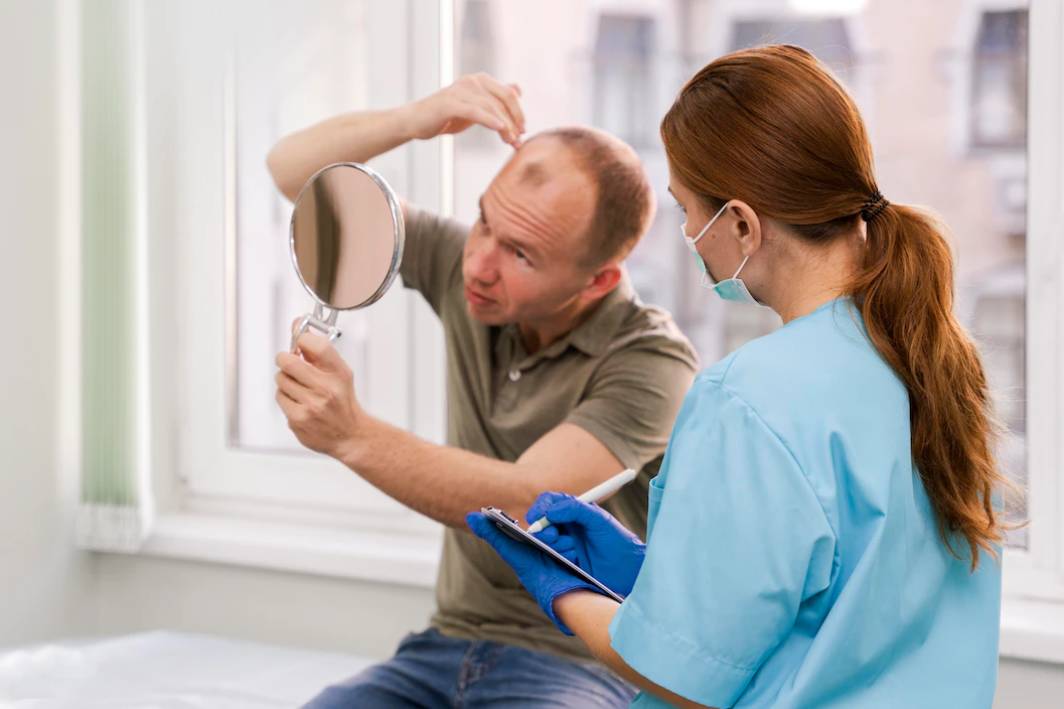A hair transplant failure is relatively rare, mainly if the doctor and patient have discussed pre-and post-operative care and have evaluated the risk factors specific to the individual patient. Still, it’s helpful for a patient to know all the likely reasons why a hair transplant could go wrong, what to do to fix it in the rare case it does, and the possible solutions.
One thing to remember is that, though hair transplant failure is relatively rare, no doctor or surgeon worldwide can guarantee the hair, once transplanted, will continue to grow in its new breeding field.
The most frequent reason for individual follicular unit graft failure during the procedure is desiccation, which happens when a graft spends too much time outside the body between being removed from the donor site and transplanted into the recipient site.
A hair transplant surgeon will work with a team of nurses and surgical assistants to ensure that every follicular unit is healthy before being transplanted into the recipient site.
Hair transplant specialists in New York City, Greenwich, Connecticut, Chicago, Illinois, Washington, D.C., Northern Virginia, Houston, Dallas, Texas, Manila, Philippines, Dubai, Abu Dhabi, United Arab Emirates, and Karachi, Pakistan will look at the patient’s remaining hair before the procedure. The doctor will then determine the likelihood of the hair transplant procedure being successful based on the quantity of healthy donor tissue available. Any skilled hair surgeon will hesitate to do a hair transplant unless an adequate amount of donor tissue is likely to provide the patient with the desired results.
While transplanting donor tissue from the donor area, there is a lot of stress on the transplanted follicular units and some of the follicles nearby. Because of this, it is typical for the follicles at the treatment site to fall out a few weeks after the treatment and for new follicles to grow in about four months. Natural hair follicles at the recipient site can lose hair due to the stress of the transplant procedure. The regrowth can be anticipated on the same timeline as the transplanted follicles; however, this is only temporary.
Finding the cause of a hair transplant’s failure is an essential first step. Once the root cause has been found, the patient can start fixing a failed hair transplant and finding a long-lasting, natural-looking solution to hair loss or thinning hair.
Steps to take in solving hair transplant failure
No one wants to experience a hair transplant failure that needs to be fixed. A hair transplant that doesn’t work can be very upsetting for the patient since getting a hair transplant to treat hair loss or thinning hair is supposed to be a happy and positive experience for the person.
Hair transplant surgeons spend a lot of time and effort planning because they share this sentiment and do not want their patients to experience hair transplant failure. As a result, they take every precaution to reduce the likelihood of a failed hair transplant as much as they can.
If a hair transplant fails, which is very unlikely, the person who had it done should first try to figure out why. A hair transplant failure could result from certain habits or medical problems. Still, the patient should have been informed of any potential risks at the initial consultation procedure by the hair transplant surgeon. That is why the patient needs to be honest with the doctor when contemplating a hair transplant treatment.
If a hair transplant fails, the patient should get in touch with a professional hair transplant doctor or clinic in their area so that they can figure out what went wrong and devise a plan of action to fix the problem permanently. Expert hair transplant surgeons at reputable hair transplant facilities in New York City, Greenwich, Connecticut, Chicago, Illinois, Washington, D.C., Northern Virginia, Houston, Dallas, Texas, Manila, Philippines, Dubai, Abu Dhabi, United Arab Emirates, and Karachi, Pakistan, know how to fix a failed hair transplant and can guarantee that any future procedures are successful and produce a permanent result.
How to find a hair surgeon who can correct a bad hair transplant?
It is understandable why a patient might be reluctant to return to the hair transplant facility that performed the subpar hair transplant; therefore, a patient looking to fix a subpar hair transplant will need to locate a new surgeon who can do it permanently.
A person who needs corrective surgery should look for a qualified and experienced surgeon with access to the most cutting-edge medical equipment and who does the most cutting-edge hair transplant procedures, especially FUE and FUT.
There are many ways to fix a bad hair transplant, so the patient should choose a hair transplant specialist with a wide range of skills and a history of success. A trained doctor should be able to give specific examples of effective treatments and be willing to meet with the patient to discuss the options available.
A patient who has previously undergone hair transplant surgery but does not want the unnatural appearance of an old-fashioned hair plug treatment may consult a hair transplant surgeon who can remove the original plugs and redistribute them in the recipient site in smaller, more natural-looking clusters.
This approach makes the most available donor tissue while ensuring that the old hair transplant is hidden and concealed. The same is true for a patient who recently underwent treatment but is dissatisfied with the results. A skilled hair transplant surgeon can artistically construct a new hairline that is much more natural-looking and gives the patient back their confidence.
Patients unsatisfied with their hair transplant results should have faith that they can still find a long-term cure for their hair loss or thinning hair.
The most crucial step in repairing a subpar hair transplant is choosing the appropriate physician. As a result, patients should be extremely cautious and patient when meeting with possible hair transplant surgeons, and it should be their aim to choose a knowledgeable medical professional who can handle their particular hair transplant needs.
Final Words
A hair transplant is usually the subsequent solution for the hair loss patient after they’ve tried everything else, such as medication, injections, etc. Consider using medical wigs or hair extensions for a temporary or semi-permanent solution. The top-notch hair wigs and extensions are made of human hair, blending perfectly with your natural hair and giving you instant length and volume. Any hairstyle on the planet will be made possible using top wigs and hair extensions. Learn more about today’s best women’s hair systems wholesale, or hair integration systems from New Times Hair.




